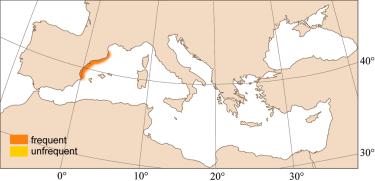
|
Relevant synonyms
Misidentification
Meristic formula
* Note: meristic counts in the Mediterranean are lower than those reported in the northeastern Atlantic.
|
|
| drawing : Tuvia Kurz |
|
SHORT
DESCRIPTION
color :
silvery, with the back dark brown and the flanks and belly whitish. In some specimens, a pale brownish pigmentation appears on the flacks. size : common (in the Mediterranean) 7-14 cm (max. 28 cm). |
DISTINGUISHING CHARACTERISTICS
BIOLOGY / ECOLOGY
|
|
1st
MEDITERRANEAN RECORD
|

|
|
DISTRIBUTION
|
ESTABLISHMENT SUCCESS
speculated reasons for success :
|
|
|
MODE OF
INTRODUCTION |
IMPORTANCE TO
HUMANS |
|
KEY
REFERENCES
|